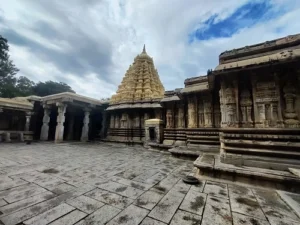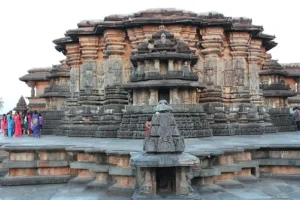Talakadu, an Indian city in the southern state of Karnataka, is home to numerous historic temples and wineries. On the left bank of the Kaveri River is where Talakadu is situated. Now, there are very few temples remaining in this city. A group of some such Hindu temples is known as Talakadu temple. They are situated in the Karnataka state of India, roughly 45 km southeast of the historically significant city of Mysore.
The five Shiva temples at Talakadu, are renowned for being buried beneath sand and dust. The Arkeshwara, Maraleshwara, Pathaleshwara, Mallikarjuna, and Vaidhyanatheshwara, are the name of the five Temples. The five Lingams in Talakadu temples are thought to symbolize Mahadev Shiva’s five faces.
Also, known as Bangalore’s Gourmet Valley, Talakadu has an exciting past. There are traces of the Ganga line of kings in the history of Talakadu. After the Cholas defeated the Ganga dynasty, the Hoysala kings took control.
A legendary story, the Curse of the Queen, the decline of royalty, and much more remains hidden beneath the sands of this village. Every time the sands from the underground city of temples are brushed away, there is a fresh discovery to make. Stories from the past and beliefs provide depth to the history of Talakadu.
History Related to Talakadu Temple:

Talakadu has grown in popularity as a travel destination for history enthusiasts, environment lovers, and spiritual seekers due to its distinctive geographical features and rich historical significance.
The history of Talakadu dates back to antiquity, including mentions of the second century CE. The Ganga dynasty, founded by King Harivarma, ruled over the region. Throughout their more than 800-year reign, the Gangas were responsible for the flourishing of trade, art, and culture. Talakadu saw the rise and fall of several dynasties over the ages, including the Cholas, Hoysalas, and Vijayanagara.
From 350 to 1050 AD, the Western Gangas were a powerful and distinguished ruling family until the Cholas overthrew them in the 11th century. In the 12th century, Talakad fell under the Hoysala Empire. The stunning Vijayanarayana Chennakeshava Temple at Belur was constructed by the Hoysala emperor.

The region was dominated by the strong Vijayanagara Kingdom rulers and the Maharajas of Mysore following the Hoysalas. Every dynasty that ruled over the town left its impression on its traditions, culture, and architecture. One of Talakadu’s interesting attractions is its huge, remarkable dunes, which surround the town and transit an estimated 30 square kilometers.
30 temples are said to be hidden beneath the sand mounds. In addition, the majority of temples are thought to have been constructed by Vijayanagar empire kings. The temples that were already there were enhanced with numerous characteristics by the Hoysalas, Cholas, and other groups.
Only a small number of temples have been dug out, though. The five Shiva temples, Pataleshwara, Maraleshwara, Arkeshwara, Mallikarjuna, and Vaidhyanatheshwara, are the most revered among them. Another well-known temple in Talakadu is the Keerthinarayana Temple.

This historic town provides travelers with a tranquil getaway from the contemporary world as well as an entrance into the past.
Stories and Curses About Talakadu:
Story of the Two Brothers:
“Talakadu” is thought to have been named for the twin brothers Tala and Kadu. There is a well-known narrative connected to the past of Talakad, which is now known as Talakadu. When they saw wild elephants worshipping the same tree while they were felling it, they realized the tree had an image of Lord Shiva and dropped their axes.
As a result of the tree’s worship, wild elephants transformed into Rishis, and the tree was magically retrieved. Everyone present at that miracle location attained moksha, and the location is now known as Talakadu.
The temple, dedicated to Veerabadra Swamy, now has two stones in front of it, symbolizing those twin brothers.
The Story of the Curse of Talakadu Temples:

A well-known story regarding the history of Talakadu Temple is the one about the curse that buried Talakadu beneath the sand.
Local legend states that following the king’s passing, the region was ruled by Wodeyar monarchs from Mysore. He had his sights set on the queen’s (Queen Alamelamma’s) jewels. However, she ran away, she drowned herself in the River Kaveri after realizing she was unable to escape.
And, before jumping into the river, she uttered a triple curse –
“Talakadu Maralagi, Malangi Maduvagi, Mysooru Arasarige Makkalagadirali,”.
The literal translation is: “Let Malangi turn into a whirlpool, let Talakadu turn into sand, and let the Rajas of Mysore not produce any successors.” And the once-wealthy village of Talakadu is now buried several meters below the surface in sand mounds.
The 5 Most Famous Talakadu Temple:

Arkeshwara Temple:
This temple is a short distance from Talakadu village. Durga and Bhairava are two other images seen in the Arkeshwara temple in addition to Linga. There is a vaastu yantram affixed on a stone. Any animal, such as a cow, is said to be cured of all ailments if it is tied to this rock while it is ill.
Maraleshwara Temple:
Constructed during the Ganga period, this temple is also among the oldest. Within the garbha griha of the temple is a massive Shiva linga. Other images found here, besides the Shiva linga, are of Karthikeya, Durga standing on the Asura Mahisha, and Mahavishnu.
Pathaleshwara Temple:
Another of the oldest temples constructed during the Ganga dynasty. Later, during the Chola era, the tower that overlooked the shrine and garbha griha underwent renovations. In addition to the Shiva linga, various images of Durga, Simhavahini, and Trimurti Brahma may be found here.
Mallikarjuna Temple:
This temple is situated rather distant from Talakadu village. One of Talakadu’s pancha lingas, the Shiva linga, is located there. Here, one can also view images of numerous more gods.
Vaidyanatheswara Temple:
It is constructed in both North and South Indian architectural styles. The temple features a Vesara tower in its shrine. Additionally, Vaidyanatheswara temple is elevated on a platform, and statues of Shiva and other gods decorate its exterior walls.
It is a very old and significant temple located in Talakadu. There is a belief that anyone who visits this temple will have all health problems resolved and all sins removed.
The doors of the temple are beautifully carved with stunning designs and pictures, and it features two huge Dwarapalakas. At the temple’s entrance is a statue of Nandi as well. There is a large hall with shrines dedicated to many gods located to the north of the temple.
Panchalinga Darshana Festival:
Every twelve years, Talakadu hosts the Panchalinga Darshana festival on the banks of the Kaveri River. The temple’s pujari separately performs puja on each Shiva linga after gathering water from Gokarna pushkarni.
Flowers and leaves from plantain stunningly decorate the temples. Throughout 5 days, thousands of people from all over the world visited the event. This is an occasion to see and receive blessings from each of the five Shiva lingas located in Talakadu.
When Khuha Yoga and Vishaka, two stars, unite on a new moon day in the Karthika month, the Panchalinga Darshana is performed. The five temples stand for the five avatar or appearances of Prabhu Mahadev Shiv Shankar.
It is customary for pilgrims to worship Gokarneswara, Chandikadevi, and the Gokarna Theertham on this day. After that, they are supposed to worship Vaidyeshwara, Arkeshwara, Pataleshwara, Maraleshwara, and Mallikarjuna. Finally, they are supposed to worship Kirtinarayana to complete their trip in a single day.
Conclusion:

The story of Talakad has all the elements necessary to draw in visitors. And the Kaveri River is the source of Talakad’s history. The Talakad’s left bank is graced with beautiful water that flows according to Kaveri’s will. The current state of Talakadu is thought to be the consequence of one of the Vijaynagar Empire’s rulers shifting the route of the water flow to build a dam for irrigation purposes.
The Kaveri River is currently a popular tourist destination with entertaining activities. Rituals in Kaveri are performed to complete “Panchalinga Darshan”. Following a long day of touring Talakadu Temple, one can get refreshments and relaxation by sitting at Kaveri River Bank.
Talakadu has seen a rise in tourism in recent years, drawing travelers from all around the nation and abroad. The town’s cultural history is being preserved, and sustainable tourism practices are being promoted by the local administration. There have been initiatives to preserve the dunes and encourage environmentally friendly activities in the region.
Furthermore, the local community has been instrumental in maintaining the customs and tales connected to Talakadu, guaranteeing that subsequent generations will be able to recognize its historical and cultural importance.

